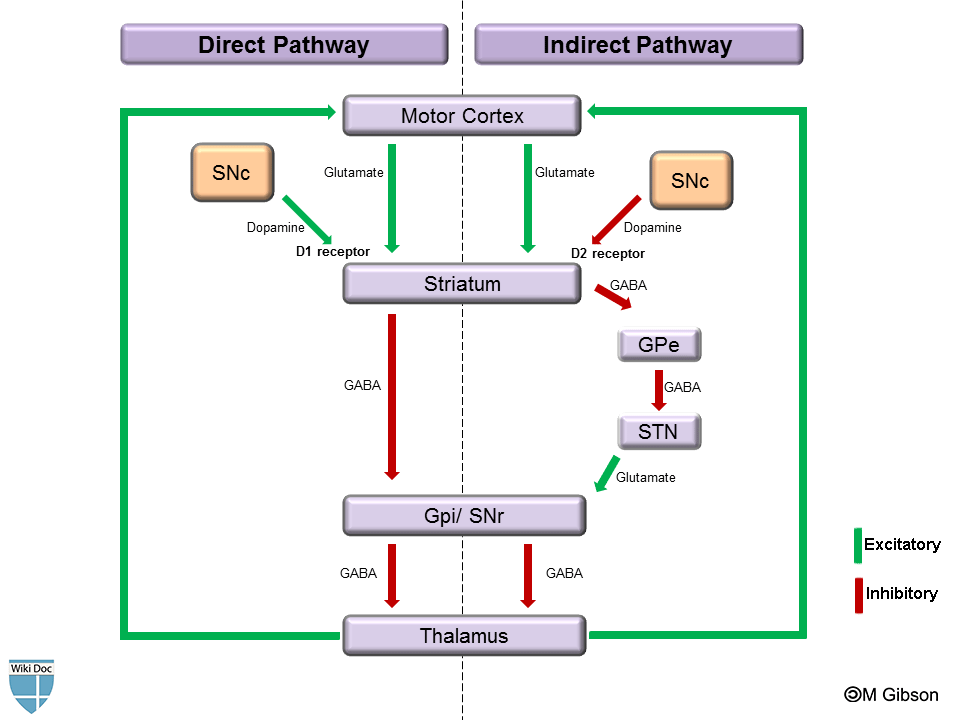WBR0590
| Author | [[PageAuthor::Rim Halaby, M.D. [1] (Reviewed by Yazan Daaboul, M.D.)]] |
|---|---|
| Exam Type | ExamType::USMLE Step 1 |
| Main Category | MainCategory::Anatomy, MainCategory::Physiology |
| Sub Category | SubCategory::Neurology |
| Prompt | [[Prompt::Deep brain stimulation (DBS) is an invasive procedure indicated for advanced Parkinson's disease. It consists of the surgical implantation of a device that sends high frequency electrical impulses into areas of the basal ganglia, particularly the subthalamic nucleus (STN) and the globus pallidus internus (GPi). It is hypothesized that the mechanism by which DBS improves parkinsonism symptoms includes hyperpolarization in the STN by DBS that results in a reduction in the subthalamic excitability. Which of the following changes in neurotransmitter release is the result of the reduction of subthalamic excitability?]] |
| Answer A | AnswerA::Reduction in glutamate release from the STN and GABA release from the GPi |
| Answer A Explanation | [[AnswerAExp::The inhibition of the STN results in a reduction of glutamate release, which leads to reduced stimulation of the GPi and a reduction in GABA release.]] |
| Answer B | AnswerB::Reduction of glutamate release from the STN and increase in GABA release from the GPi |
| Answer B Explanation | AnswerBExp::GABA release is reduced following the reduction of subthalamic excitability. |
| Answer C | AnswerC::Increase of glutamate release from STN and increase in GABA release from GPi |
| Answer C Explanation | AnswerCExp::Release of both glutamate and GABA is reduced following the reduction of subthalamic excitability. |
| Answer D | AnswerD::Increase in glutamate release from the STN and reduction of GABA release from the GPi |
| Answer D Explanation | AnswerDExp::Glutamate release is reduced following the reduction of subthalamic excitability. |
| Answer E | AnswerE::Reduction of glutamate release from the STN with no change in GABA release from the GPi |
| Answer E Explanation | AnswerEExp::GABA release is reduced following the reduction of subthalamic excitability. |
| Right Answer | RightAnswer::A |
| Explanation | [[Explanation::The indirect pathway of the basal ganglia begins when the motor cortex stimulates the striatum, which consequently releases GABA. GABA released by the striatum has an inhibitory effect on the globus pallidus externus (GPe), and hence leads to less GABA release from GPe which in turn regulates the STN. Normally the STN releases glutamate stimulating GPi to release GABA. GABA released by the GPi decreases the firing of the thalamus towards the motor cortex and consequently decrease motion. Inhibition of the STN leads to decrease glutamate release causing less stimulation of the GPI and hence less release of GABA. Decrease in the inhibitory effect of GABA on the thalamus causes increase in motion.
Shown below is an image summarizing the direct and indirect pathway of the basal ganglia.  Educational Objective: In the indirect pathway of the basal ganglia, STN stimulates GPi through glutamate. GPi releases GABA and decrease excitatory signal release from the thalamus. The outcome is fine tuning of voluntary movement by decreasing motion. |
| Approved | Approved::No |
| Keyword | WBRKeyword::Basal ganglia, WBRKeyword::STN, WBRKeyword::Neurotransmitter |
| Linked Question | Linked:: |
| Order in Linked Questions | LinkedOrder:: |